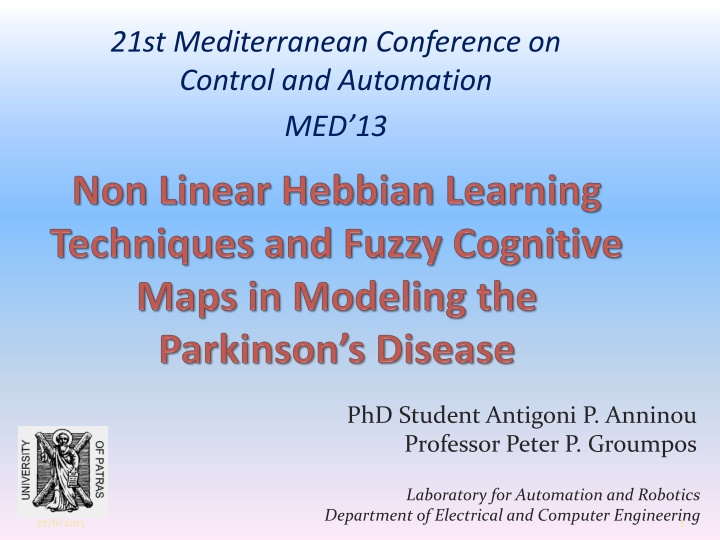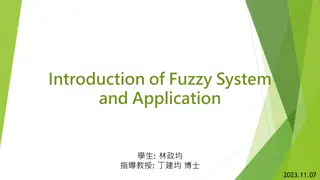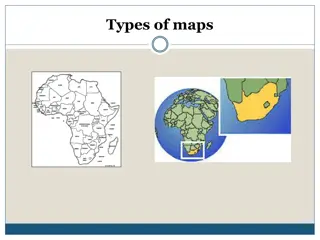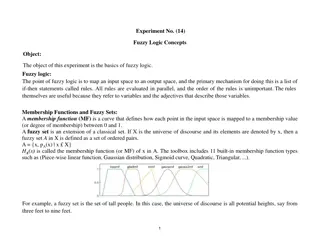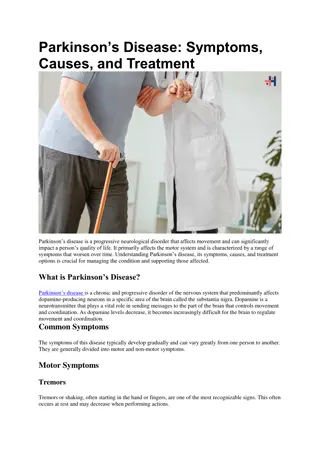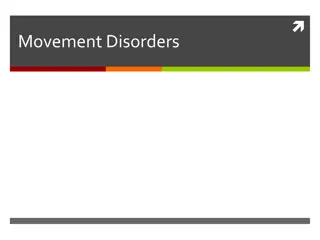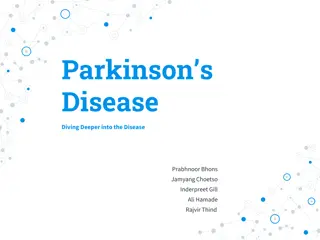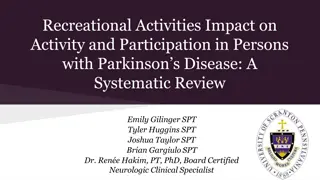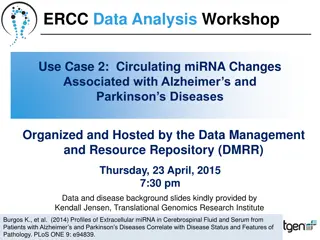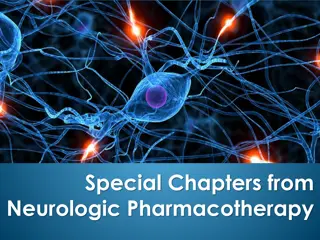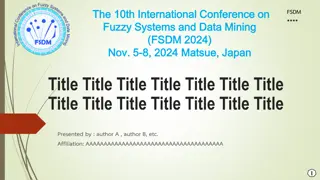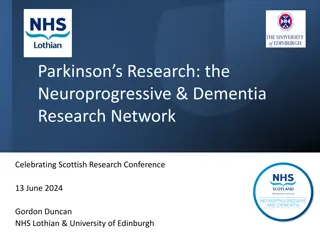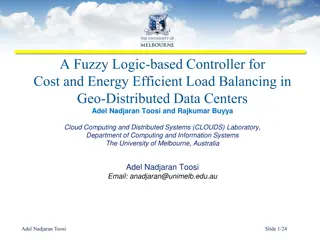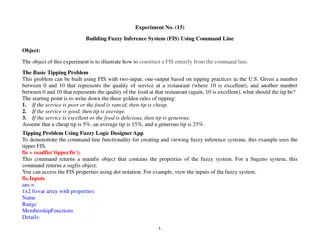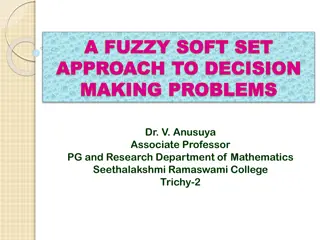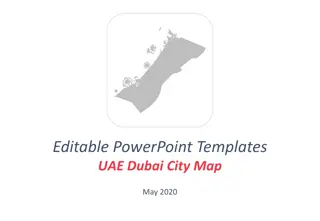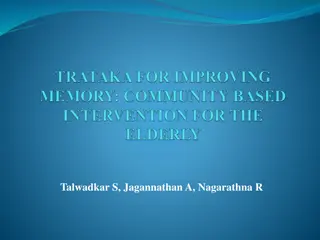Fuzzy Cognitive Maps in Parkinson's Disease Diagnosis
This content discusses the construction and training of Fuzzy Cognitive Maps (FCM) for modeling a Decision Support System in Parkinson's disease diagnosis. It explains the methodology, interconnections between concepts, simulation results, and weaknesses of FCM. The aim is to provide a tool for aiding in the diagnosis of Parkinson's disease.
Download Presentation

Please find below an Image/Link to download the presentation.
The content on the website is provided AS IS for your information and personal use only. It may not be sold, licensed, or shared on other websites without obtaining consent from the author.If you encounter any issues during the download, it is possible that the publisher has removed the file from their server.
You are allowed to download the files provided on this website for personal or commercial use, subject to the condition that they are used lawfully. All files are the property of their respective owners.
The content on the website is provided AS IS for your information and personal use only. It may not be sold, licensed, or shared on other websites without obtaining consent from the author.
E N D
Presentation Transcript
21st Mediterranean Conference on Control and Automation MED 13 PhD Student Antigoni P. Anninou Professor Peter P. Groumpos Laboratory for Automation and Robotics Department of Electrical and Computer Engineering 27/6/2013 1
Outline Problem Formulation Fuzzy Cognitive Maps Non-Linear Hebbian Learning Decision Support System in Parkinson s Disease Simulation Results Conclusions 27/6/2013 2
Aim Construction and training of a Fuzzy Cognitive Map (FCM) in modeling a Decision Support System, to help in diagnosis concerning the diseaseof Parkinson 27/6/2013 3
Fuzzy Cognitive Maps (FCM) (1/5) Modeling method for describing particular domains Fyzzy-graph representing causal reasoning structures for 27/6/2013 4
Fuzzy Cognitive Maps (2/5) Nodes: Represent the system s concepts orvariables Arrows: Interconnection between nodes. Show relationship between them. W: Interrelationship between two nodes: W>0 positive causality W<0 negative causality W=0 no relationship the cause-effect 27/6/2013 5
Fuzzy Cognitive Maps (3/5) The value of each concept at every simulation step is calculated, computing interconnected concepts to the specific concept, by applying the following calculation rule: the influence of the 6 27/6/2013
Fuzzy Cognitive Maps (4/5) Ai(k+1): thevalueof the concept Ciat the iteration step k+1 Ai(k): thevalue of the concept Cjat the iteration step k Wij : the weight of interconnection from concept Ci to concept Cj k1: the influence of the interconnected concepts in the configuration of the new valueof theconcept Ai k2: the proportion of the contribution of the previous value of theconcept in the computation of the new value f : the sigmoid function 27/6/2013 7
Fuzzy Cognitive Maps (5/5) Weaknesses Direct dependence of the initial knowledge of experts Convergence to undesirable situations Solution Training the FCM 27/6/2013 8
Non-Linear Hebbian Learning (NHL) (1/2) Increase the effectiveness of FCMs and their implementation in real problems Update weights associated only with edges that are initially suggested by experts All concepts in FCM model are triggered at each iteration step and change their values Output concepts Desired Output Concepts (DOCs) 27/6/2013 9
Non-Linear Hebbian Learning (2/2) Algorithm that modifies the weights: h:learning parameter g: weight reduction parameter Nodes are triggered simultaneously and interact in the same iteration step, and their values updated through this processof interaction 27/6/2013 10
Criteria 1st : Minimization of the objective function F DOCi: the value of the output concept i as indicated in each iteration Ti: the mean target value of the concept DOCi m: the number of the desired output nodes 2nd : Minimization of the variation of two subsequent values of DOCs F2 = | DOCi(k+1)- DOCi(k) | 27/6/2013 11
NHL Algorithm Read input state A0and initial weight matrix W0 Repeat foreach iteration step k - Calculate Aiaccording to (1) - Update Wij(k)according to (3) - Calculate the two criterion functions Repeat until the termination conditions are met Return the final weights Wfinal and concept values in convergence region 27/6/2013 12
Schematic Representation of NHL algorithm 27/6/2013 13
NHL Parameters The parameters arise from trials and experiments 0<h<0.1 0.9<g<1 27/6/2013 14
Decision Support System Definition: Interactive computer based support system for making decisions in any complex system, when individuals or a team of people are trying to solve unstructured problems on an uncertain environment Aim: Reach acceptable and realistic decisions Methodology: Exploitation of experts experience 15 27/6/2013
Why to model Decision Support Systems with FCMs High amount of data and information from interdisciplinary sources Information may be vague or missing Procedure is complex Many factors may be complementary, contradictory or competitive 27/6/2013 16
Decision Making Support System in Parkinson s Disease (1/2) Concepts: C1: Body Bradykinesia C2: Rigidity C3: Postural Instability C4: Movement of upper limbs C5: Gait C6: Tremor C7: Stage of Parkinson s disease five stages (output) 27/6/2013 17
Decision Making Support System 27/6/2013 18
The Fuzzy Cognitive Map Model 19 27/6/2013
Simulation Results 1st Scenario: Suppose that the physician decided as initial values of the inputs the following: C1 Strong C2 Strong C3 Medium C4 Medium C5 Strong C6 Very Strong After COA defuzzyfication method the initial values for the concepts would be: A(0)=[0.75 0.75 0.5 0.5 0.75 1 1] 27/6/2013 20
Subsequent values of concepts till convergence 27/6/2013 21
Output Without the learning algorithm Patient Stage 2 NHL Algorithm Patient Stage 3 27/6/2013 22
2nd Scenario: C1 Weak C2 Weak C3 Medium C4 Medium C5 Strong C6 Zero After COA defuzzyfication method the initial values for the concepts would be: A(0)=[0.75 0.75 0.5 0.5 0.75 1 1] 27/6/2013 23
Subsequent values of concepts till convergence 27/6/2013 24
Output Without the learning algorithm Patient Stage 2 NHL Algorithm Patient Stage 1 27/6/2013 25
Results Weight matrices influence the result Easy to use the proposed software tool Without the learning algorithm: Few recursivesteps (until 9 steps) Fastdiagnosis Convergence to undesired equilibrium points Demands training NHL Algorithm: Much more recursive steps Difficulty and many trials in order to find the right parameters h and g Equilibrium points closer to the reality 27/6/2013 26
Conclusions (1/2) Modeling with this tool closely represents the way experts perceive it NHL algorithm offers more reasonable results according to physicians NHL algorithm needs more iteration steps in order to reach an equilibrium point By using FCM without a learning algorithm to train it, we have a fast model that after a few iteration steps reaches an equilibrium point The suggested model is easily altered to incorporate other diseases 27/6/2013 27
Conclusions (2/2) In most cases, FCMs are constructed manually, and, thus, they cannot be applied when dealing with large number of variables. In such cases, their development could be significantly knowledge and skills of the expert. Thus, it is essential to use learning algorithms toaccomplish this task Despite the early obtained encouraging results, we still need the opinion of the physicians as to how useful can this FCM modeling approach be to Parkinson s disease. Future collaboration and consultation with physicians can help this effort affected by the limited 27/6/2013 28
Thank you for your attention PhD Student Antigoni P. Anninou Email: anninou@ece.upatras.gr Professor Peter P. Groumpos Email: groumpos@ece.upatras.gr 27/6/2013 29
